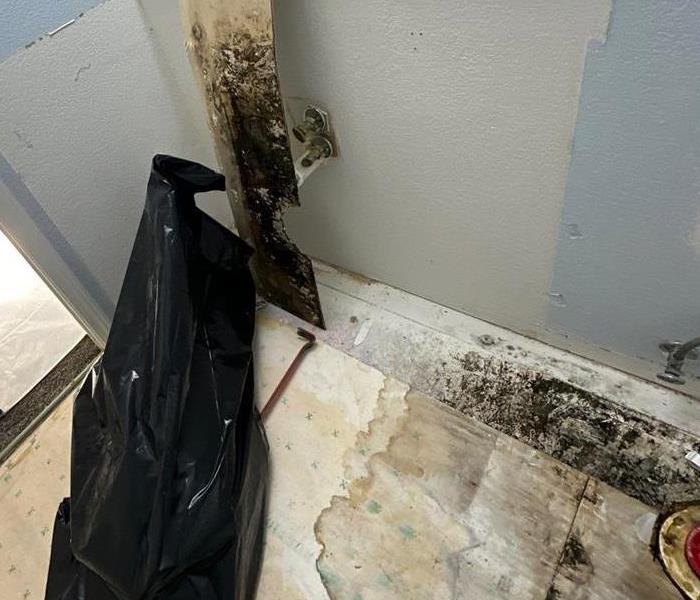Mold Removal vs. Mold Remediation: Understanding the Difference for Effective Solutions
10/1/2024 (Permalink)
Mold growth in your home or business can be an alarming discovery. Whether it’s caused by moisture buildup, water damage, or inadequate ventilation, mold can spread rapidly if not addressed properly. When it comes to dealing with mold, two common terms are often used interchangeably: mold removal and mold remediation. While they may sound similar, there are key differences between the two processes.
In this blog, we’ll break down the differences between mold removal and mold remediation and explain why professional services, like those provided by SERVPRO®, are essential for addressing mold issues effectively.
What Is Mold Removal?
Mold removal refers to the process of physically removing mold from a surface. This may involve cleaning, scrubbing, or scraping mold off walls, floors, or other affected areas. While this process can reduce visible mold, it’s important to note that mold spores are microscopic and often remain in the air or on surfaces even after visible mold is gone.
The Limitations of Mold Removal
- Surface-Level Cleaning: Mold removal only addresses the surface where the mold is visible. It doesn’t tackle the root cause of mold growth, such as moisture problems or poor ventilation.
- Incomplete Results: Because mold spores are microscopic and airborne, simply cleaning the surface doesn’t remove the mold spores from the environment. These spores can land on other surfaces and cause mold to grow again if conditions are favorable.
- Temporary Fix: Without addressing the underlying issue, mold can easily return, making mold removal a temporary solution at best.
What Is Mold Remediation?
Mold remediation, on the other hand, is a comprehensive process that involves not only removing the mold but also addressing the underlying factors that contribute to mold growth. The goal of mold remediation is to restore mold levels to a natural, safe level and prevent future mold growth by eliminating the source of the problem.
The Mold Remediation Process
- Inspection and Assessment: The first step in mold remediation is identifying the extent of the mold growth and determining its cause. Professional mold remediation services like SERVPRO conduct thorough inspections to find hidden mold and areas of moisture.
- Containment: To prevent mold spores from spreading to unaffected areas of the property, containment measures are used. SERVPRO uses specialized containment techniques such as negative air chambers and physical barriers to isolate the affected areas.
- Air Filtration: High-efficiency air scrubbers and HEPA vacuums are used to capture mold spores from the air and remove them from the environment. This reduces the risk of mold spores spreading to other areas of the building.
- Mold Removal: Once containment is established, the actual removal process begins. Depending on the severity of the infestation, mold remediation specialists may use antimicrobial treatments, remove contaminated materials like drywall or insulation, and deep clean surfaces.
- Addressing Moisture Issues: One of the most critical aspects of mold remediation is addressing the moisture issue that caused the mold in the first place. This might involve repairing leaks, improving ventilation, or installing dehumidifiers to prevent excess moisture from creating a favorable environment for mold.
- Cleaning and Restoration: After the mold is removed, cleaning and sanitizing the affected areas is crucial to prevent future growth. SERVPRO uses specialized cleaning techniques and equipment to ensure the area is properly restored. If structural materials were damaged by mold, restoration services may also be needed.
Key Differences Between Mold Removal and Mold Remediation
The main difference between mold removal and mold remediation is the depth and effectiveness of the process. Mold removal is a surface-level cleaning technique that addresses only the visible mold, while mold remediation is a comprehensive solution that tackles both the visible mold and the underlying causes of the problem.
Mold removal focuses on eliminating mold from the surface, whereas mold remediation involves a more in-depth approach, including containment, air filtration, and moisture control. Mold remediation is designed to prevent mold from coming back by addressing the root cause, while mold removal may only offer temporary relief.
Why Professional Mold Remediation Is Important
While mold removal may seem like a quick fix, it doesn’t provide a long-term solution. Attempting to remove mold yourself without understanding its root causes can lead to further complications, especially if mold spores spread to other areas of the home or business.
SERVPRO of Commerce City has professional mold remediation services that go beyond just removing visible mold. We take a comprehensive approach, ensuring that mold is contained, cleaned, and prevented from returning. Our team of certified technicians is trained to handle all types of mold problems, from small mold patches to widespread infestations in commercial properties. We use state-of-the-art equipment and proven techniques to safely and effectively restore your property.
If you’re dealing with mold in your home or business, contact SERVPRO of Commerce City for expert mold remediation. We’ll assess the situation, contain the mold, remove it safely, and address any moisture issues to prevent future growth. Let us help restore your property and peace of mind.





 24/7 Emergency Service
24/7 Emergency Service
